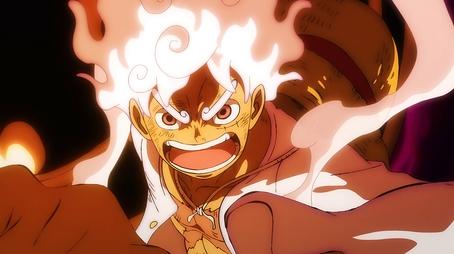Ask Your Own Question
What is the plot?
The episode opens with the intense battle between Luffy and Kaido reaching a critical point. Kaido pushes off the bouncy, rubbery ground of Onigashima and launches himself at Luffy, who counters by using his lightning-like rubber abilities to stretch and evade Kaido's attack. The fight is fierce, with both combatants landing powerful blows, showcasing Luffy's awakened Devil Fruit powers and Kaido's overwhelming strength.
Meanwhile, on the performance floor of Onigashima, the people gathered there express their resolve, agreeing that it is acceptable to die if it means Kaido will be defeated. This collective determination contrasts sharply with Usopp's refusal to accept death or let Kin'emon or Kiku perish as they struggle against the flooding waves caused by the battle's destruction.
The scene shifts to a flashback where Hyogoro and other samurai recall the tragic history of Wano Country, which has been frozen in time for 20 years under Kaido's tyranny. They remember the suffering endured by their families and the land, fueling their desire to restore true smiles and freedom to Wano.
Back in the present, the battle escalates as Luffy and Kaido prepare to unleash their ultimate attacks. Luffy, holding onto Kaido's stretched arm, ignites himself in flames, signaling his readiness to end the fight. Kaido tells Luffy he doesn't need to worry about him running away, emphasizing that the final clash is imminent.
Suddenly, a colossal fist the size of Onigashima itself, dubbed the Bajrang Gun, appears, dwarfing everything beneath it. Luffy urgently yells at Momonosuke to move Onigashima out of the way to prevent catastrophic destruction. This massive attack sets the stage for the final confrontation between Luffy and Kaido.
Throughout the episode, Momonosuke is shown grappling with the weight of his responsibilities. He experiences visions or spiritual encounters with his mother, father, and sister, which strengthen his resolve. Motivated by their spirits, Momonosuke begins to push Onigashima away from the capital to save the people below from the impending devastation.
The episode closes on this tense moment, with the fate of Wano hanging in the balance as Luffy and Kaido prepare for their ultimate showdown and Momonosuke struggles to protect his homeland from ruin. The episode serves as both a culmination of 20 years of suffering and prayers and a pivotal turning point in the liberation of Wano Country.
What is the ending?
In the ending of One Piece, Season 21, Episode 1075, titled "20 Years' Worth of Prayers! Take Back the Land of Wano!", the Straw Hat Pirates and their allies finally succeed in their long-fought battle against Kaido and the Beast Pirates. The people of Wano, who have suffered under tyranny for two decades, rise up in celebration as they reclaim their homeland. Luffy, having defeated Kaido, stands triumphant, embodying the hope and resilience of the Wano citizens. The episode concludes with a sense of unity and renewal, as the dawn of a new era begins for Wano.
As the episode unfolds, the scene opens with the remnants of the fierce battle still echoing in the air. The landscape of Wano, once shrouded in darkness and despair, begins to show signs of life and hope. The camera pans over the battered but determined faces of the Wano citizens, who have gathered to witness the culmination of their long-held dreams. Their eyes reflect a mix of fear and anticipation, knowing that the moment they have prayed for has finally arrived.
In the heart of the battlefield, Luffy stands tall, his body battered but his spirit unyielding. The remnants of his fight with Kaido linger in the air, but the resolve in Luffy's eyes shines brighter than ever. He recalls the sacrifices made by his friends and the people of Wano, fueling his determination to end Kaido's reign. As he takes a deep breath, the atmosphere shifts; the clouds part, and a ray of sunlight breaks through, symbolizing the dawn of a new era.
Meanwhile, Zoro, Sanji, and the other Straw Hat members rally around Luffy, their expressions a mix of exhaustion and exhilaration. Each of them reflects on their personal journeys and the bonds they have forged throughout this battle. Zoro, with his sword at the ready, stands as a testament to loyalty and strength, while Sanji, ever the protector, ensures that the citizens are safe from any remaining threats.
As the final confrontation with Kaido reaches its climax, the scene shifts to the fierce battle between Luffy and Kaido. The two clash with immense power, their attacks shaking the very ground beneath them. Luffy, drawing on the strength of his friends and the hopes of the Wano people, unleashes a final, devastating blow. The moment is charged with emotion, as Luffy's determination to protect his friends and the people of Wano culminates in this decisive strike.
With Kaido finally defeated, the atmosphere shifts dramatically. The citizens of Wano, who have endured years of suffering, erupt in joyous celebration. Their cries of relief and happiness fill the air, echoing through the valleys and mountains of Wano. The camera captures the tears of joy streaming down their faces, a powerful testament to their resilience and hope.
As the episode draws to a close, the Straw Hat Pirates stand together, united in their victory. Luffy, with a wide grin, looks out over the land of Wano, now bathed in the warm glow of the sun. The people gather around them, expressing their gratitude and admiration. Each member of the crew reflects on their journey, their hearts filled with a sense of purpose and belonging.
The final scene captures the essence of Wano's rebirth. The citizens begin to rebuild their homes, planting seeds of hope in the fertile soil of their land. Luffy and his crew, having fulfilled their promise to liberate Wano, prepare to set sail once more, their hearts filled with the knowledge that they have made a difference. The episode ends on a hopeful note, with the sun rising over Wano, symbolizing the dawn of a new era for its people and the adventures that lie ahead for the Straw Hat Pirates.
Is there a post-credit scene?
In episode 1075 of One Piece, titled "20 Years' Worth of Prayers! Take Back the Land of Wano!", there is indeed a post-credit scene that adds depth to the ongoing narrative.
As the episode concludes, the screen fades to black before transitioning to a serene view of the Wano countryside, bathed in the warm glow of the setting sun. The camera pans over lush green fields and cherry blossom trees, symbolizing the hope and renewal that has begun to blossom in the land after years of oppression.
In this scene, we see a group of villagers gathered together, their faces illuminated with joy and relief. They are sharing stories of the past, reminiscing about the hardships they endured under Orochi's rule and the sacrifices made by the Akazaya Nine. Their laughter and tears of happiness reflect a collective sense of liberation and the dawning of a new era.
Among them, a young girl holds a small, hand-painted banner that reads "Freedom for Wano!" Her eyes sparkle with determination, embodying the spirit of the next generation that will carry forward the legacy of their ancestors. The camera zooms in on her, capturing the innocence and hope she represents.
As the scene shifts, we see a silhouette of Luffy and the Straw Hat crew standing on a cliff overlooking the village, their expressions a mix of pride and resolve. Luffy, with his signature grin, declares that they will protect this newfound freedom at all costs. The crew nods in agreement, their camaraderie palpable as they prepare for the challenges that lie ahead.
The post-credit scene concludes with a close-up of the sun setting behind the mountains, symbolizing both an end and a new beginning for Wano. The screen fades to black, leaving viewers with a sense of anticipation for the adventures that await the Straw Hats and the people of Wano.
What role does Kozuki Momonosuke play in the battle for Wano in this episode?
In episode 1075, Kozuki Momonosuke steps into a pivotal role as he embraces his destiny as the rightful heir of Wano. He is filled with a mix of determination and anxiety as he rallies the samurai and citizens to reclaim their homeland from the oppressive rule of Kaido and Orochi. His internal struggle is palpable as he grapples with the weight of his family's legacy and the expectations placed upon him.
How does Luffy's presence impact the morale of the Wano citizens during the battle?
Luffy's presence in episode 1075 serves as a beacon of hope for the citizens of Wano. His unwavering spirit and fierce determination to fight against tyranny inspire those around him. As he engages in battle, the citizens witness his strength and resolve, which reignites their own fighting spirit. The emotional weight of their long-suffered oppression contrasts sharply with Luffy's carefree attitude, creating a powerful dynamic that motivates them to stand up and fight alongside him.
What is the significance of the '20 years' worth of prayers' mentioned in the episode?
The phrase '20 years' worth of prayers' resonates deeply throughout episode 1075, symbolizing the long-standing hopes and dreams of the people of Wano who have endured suffering under Kaido's rule. This collective yearning for freedom and justice fuels the characters' motivations, particularly for the samurai and the Kozuki clan. It serves as a reminder of the sacrifices made by those who fought before them and the importance of reclaiming their homeland.
How does the episode depict the relationship between Zoro and the other samurai?
In episode 1075, Zoro's relationship with the samurai is highlighted through moments of camaraderie and mutual respect. As he fights alongside them, Zoro's fierce loyalty and combat prowess earn their admiration. The samurai, initially skeptical of outsiders, begin to see Zoro as a true ally in their struggle. This bond is further emphasized during intense battle sequences where they coordinate their attacks, showcasing a growing trust and unity in their shared goal.
What emotional struggles does Kin'emon face in this episode?
Kin'emon experiences profound emotional turmoil in episode 1075 as he reflects on the loss of his comrades and the weight of their mission. Haunted by memories of the past and the sacrifices made for Wano's freedom, he grapples with feelings of guilt and responsibility. His determination to honor the fallen drives him forward, but moments of vulnerability reveal his fear of failure and the potential loss of hope for his people.
Is this family friendly?
In the episode "20 Years' Worth of Prayers! Take Back the Land of Wano!", there are several elements that may be considered objectionable or upsetting for children or sensitive viewers:
-
Violence and Combat: The episode features intense battles and confrontations, showcasing characters in perilous situations. There are scenes of fighting that may be graphic or intense, which could be distressing for younger viewers.
-
Emotional Trauma: Characters express deep emotional pain and suffering due to past events, including loss and oppression. This can evoke feelings of sadness and may be heavy for sensitive audiences.
-
Themes of Oppression: The storyline addresses themes of tyranny and suffering under a cruel regime, which may be difficult for some viewers to process, especially younger children.
-
Death and Sacrifice: There are references to characters who have died or sacrificed themselves for a cause, which can be a heavy topic for children.
-
Dark Imagery: The visual representation of the Wano Country's struggles includes dark and foreboding imagery that may be unsettling.
These elements contribute to a narrative that, while rich in storytelling and character development, may not be suitable for all audiences, particularly younger children or those sensitive to themes of violence and emotional distress.


